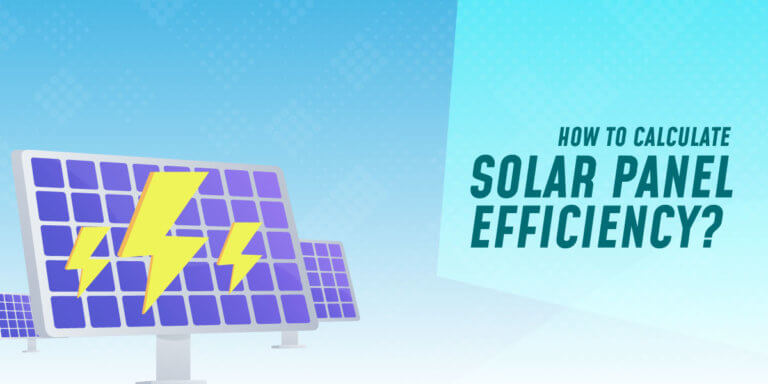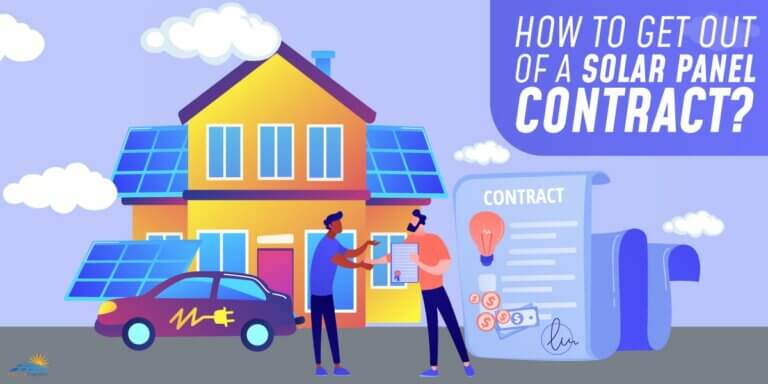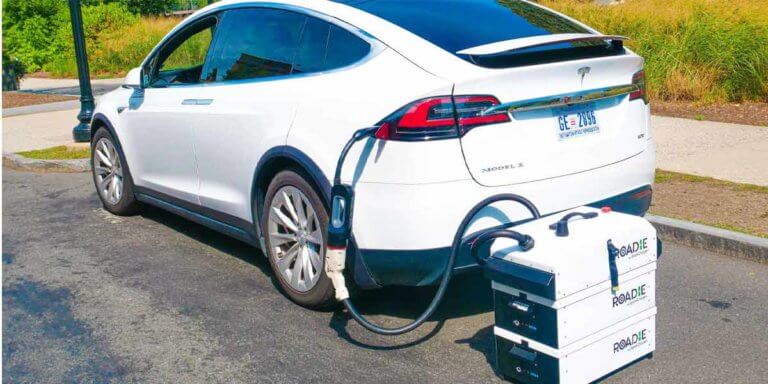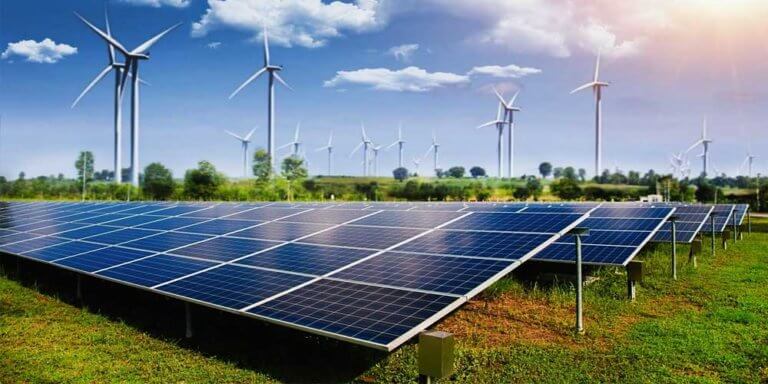How Much Solar Power Do I Need For My RV?

The cost of solar panel technology has decreased for customers over the last ten years. As a result, a lot of individuals are drawn to the concept of installing solar electricity in their RVs. As a result many RV companies started including pre-wired ports for solar panels in RVs to appeal more customers. They have been able to go further “off the grid” and keep drydocking for longer thanks to it.
Modern solar panels are not only environmentally friendly but also effective enough to lessen or even completely replace an RV’s requirement for a conventional gasoline or diesel generator.
A premium fifth wheel or Class A motorhome may require 240 to 360 Amp Hours of solar electricity to adequately operate its array of appliances and creature comforts, compared to a typical travel trailer’s 120 Amp Hour solar power requirement.
The time it takes to receive a complete return on your initial investment will thus depend on how broad a range there is. You need to know several things before you start if you’re considering switching to solar panel technology.
Take a deeper look at how solar power functions to determine how much solar electricity your RV actually needs.
Significance Of Solar Power In RV
There are several advantages to purchasing RV solar panels and using them to power your recreational vehicle. A solar panel is advantageous since it has no moving parts, unlike a generator.
Additionally, it runs quietly and is odorless. Additionally, it needs the least amount of upkeep. Even if all you need is to keep a single battery charge, you will be able to choose the best solar panel system for you.
In order to power all the comforts and appliances that are a part of your daily routine, you will also need to decide on your battery bank storage. Buy batteries with a capacity of at least two times your use.
The fact that solar energy is free is an additional advantage. It uses the sun’s energy, which is free, and does not require expensive fuel. Given that you don’t have to deal with filthy gasoline or oil, it is also clean.
Furthermore, you will appreciate that the solar panel will never bother your neighbors. It doesn’t make your neighbors put up with the noise or breathe in the pollutants that generators often produce.
Working Of Solar Power In RV
The most crucial concept to grasp is that solar panels are simply one solution component. They function collectively as a broader system to power your apparatus. One of the potential energy sources for your RV is solar power.
The alternatives include using a generator, your car’s alternator, which produces electricity as you drive, and shore power (plugging into the outlet at your campground) (if you have one). These sources might be active or inactive at any one time. For instance, solar panels only turn on when the sun is shining, and shore electricity is only available when the rig is connected.
Batteries in your RV store energy from all the different energy sources. As a result, you can consume power even when no energy sources are running. It is crucial to keep in mind that the batteries are full once they are. More than 100% of your rig’s battery capacity cannot be stored.
Additionally, unlike a residential solar energy system, you cannot sell extra electricity to the utility. This implies that it is crucial to size the solar power system on your RV properly. You can run out of power when needed if it’s too small. If it’s too big, you’re just wasting money.
How Much Solar Do I Need For My RV?
It would be best to first comprehend the output of all the energy sources you have access to calculate your solar power requirements. You will need to read up on the intricacies of your power system because there is a LOT of arithmetic involved. Generators have their own capacity restrictions and are operated through an inverter or converter.
It’s vital to remember that out of all the energy options, and solar panels are often the weakest. A 100-watt panel, which is a typical size for RVs, can only produce 100 watts at its most efficient level. It will produce only a little more than eight amps in the best situation. You can create at most 25 amps per hour with three of these panels.
This does not imply that solar energy should be disregarded. Instead, it indicates that further investigation is necessary to determine whether solar energy is a good fit for you and, if so, how much you truly need.
Solar power might not be particularly useful if you mostly usually use shore power or spend a lot of time driving. However, even if you have a generator, solar power may be necessary if you camp without connections for a few days.
What Size Solar System Do I Need For My RV?
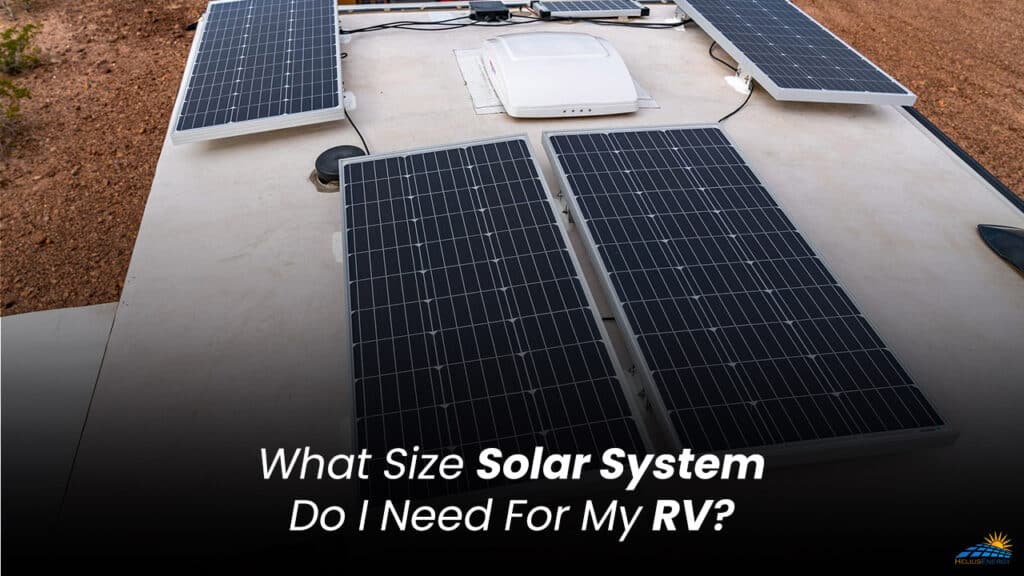
Depending on your needs and budget, solar power systems can be scaled up or down to fit your needs.
Method 1 – Do A Camping Test
This process takes some time, but it will prevent you from underestimating and not having enough solar or overestimating and spending too much on your solar system.
Charge your batteries to capacity if you already have them before going off the grid for a camping weekend. As you normally would, use your RV. Try to maintain your usual level of electricity use. You want the results of your power audit to be accurate.
Use a battery monitor, such as the Victron BMV-712, to monitor the amp-hour usage during a 24-hour period and the state of your battery bank’s charge. Make a note of how many amp-hours you used throughout your 24-hour test session.
To calculate your watt-hour power usage, multiply your amp-hour consumption by the battery voltage (often 12.6V for lead-acid batteries or 13V for lithium). For instance, your battery monitor reports that you consumed 135 amp-hours of your lithium battery bank over the course of 24 hours (135 amp-hours times 13 volts = 1,755 watt-hours).
You might also do the same test when plugged into shore power. To determine your watt-hour usage over a 24-hour (or longer) period, use a power monitor like the Watchdog surge protector and power monitor.
Method 2- Identify The AC And DC RV Appliances
Estimating your power consumption based on the gadgets and appliances you use and how much time you spend using them each day is one method. You aim to calculate the approximate daily watt-hour consumption.
You should be able to find the wattage or amps used by each of your appliances and gadgets on their labels. For watts, multiply the amps by the voltage if the gadget only lists amps. For instance, the label on a 120-volt hair drier could state that it uses 13 amps. The hairdryer would use around 1560 watts of electricity (120 x 13 = 1,560).
Once you know how many watts each of your gadgets use, you need to calculate how many hours a day you generally use each. You multiply the appliance’s usage duration by its power demand to obtain watt-hours.
Repeat this procedure now with all of your equipment and gadgets. Once you know how many watt-hours each gadget uses daily, add them to obtain the total. When calculating the number of solar panels you require, you’ll use this total number of watt-hours.
Let’s look at rough estimation of wattage usage of appliances that might be installed in the RV.
| Appliance | Watt | Hour Used | Daily Electricity Consumption |
|---|---|---|---|
| Microwave | 800 | 1/2 Hour | 400wh |
| Small Fridge | 40 | 24 Hours | 960wh |
| Water Heater | 1440 | 1/2 Hour | 720wh |
| 4 LED Bulbs | 40 | 5 Hours | 200wh |
| Water Purifier | 60 | 1 Hour | 60wh |
RV Solar Power Calculator
For the solar power system on your RV to be properly sized, you must learn some fundamental terminology: Amps vs. Watts: Watt ratings apply to both solar panels and electrical loads.
Power is measured in units called watts. Amps, abbreviations for amperes, express a current in RV batteries. You also need to be familiar with volts, or electrical potential units, in order to convert between watts and amps.
The rest is simple:
W = Amps * Volts
Watts x Volts = Amps
Watts remains constant since they are the common unit of power. Watts can come in various counts, but a watt always remains the same.
The same is not true for amps since current and voltage levels can fluctuate, nor is it true for volts because voltage levels can change. Since you are aware that your RV may accept either 12 volts DC (direct current) from the batteries or 120 volts AC (alternating current) from shore power, it is quite simple to see this voltage change.
You must comprehend amp-hours, or the battery’s entire capacity, in order to determine how much useful power you actually have.
Unless specified on the battery, amp-hours are normally calculated based on 20 hours of total usable time. Simply divide the amp-hours (AH) mentioned on the battery by 20 (or another number if specified on the label) to get how many amps per hour.
How Many Solar Panels Do I Need For My RV?
You must select and determine how many solar panels you will need to buy and install based on how much electricity you will use each day. Naturally, this figure will also be influenced by the size of your trailer and the regions you frequently visit.
But generally speaking, we can say that a typical trailer has adequate room on its roof for two, and occasionally even three, 4820-inch solar panels. With this many panels, there won’t be any shade between them, and you’ll always have adequate electricity to run your appliances.
Conclusion
Consider buying solar panels if you want to get away from the loud campsites, generators, and connections while still taking advantage of your RV experience and ensuring that your vehicle has electricity. By avoiding using a generator, you are lowering your carbon impact.
In general, photovoltaic cells in solar panels are growing better at converting solar energy into electricity at a lower cost. Make sure you are well informed of your RV’s unique solar power needs. By doing so, you can choose a solar panel that meets your demands.

